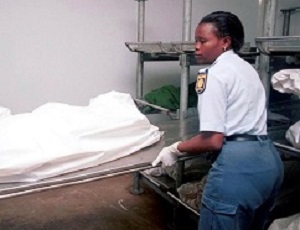
Statistics South Africa has released its exhaustive analysis of mortality and causes of death in 2015, noting a 3% decline to 460,236 deaths. The three leading causes were tuberculosis, diabetes and cerebrovascular disease.
Key findings summary:
This statistical release presents information on mortality and causes of death in South Africa for deaths that occurred in 2015 based on all death notification forms from the civil registration system maintained by the Department of Home Affairs (DHA). Specifically, the release provides an analysis of mortality by selected socio-demographic characteristics and statistics on the causes of death based on the underlying cause of death. Additional information for the period 1997 to 2014 (updated for late registrations) is also provided as well as underlying causes of death from 2014 to 2015 to show levels and trends of registered deaths. In 2015, the majority of the deaths (77,5%) were registered within the three days stipulated by the legislative framework. Additionally, adult completeness of death registration for the intercensal period for 2011-2016 was 96%, showing an improvement from the 94% observed between 2007 and 2011.
The total number of deaths which occurred in 2015 was 460 236. The highest number of deaths that occurred in 2015 were among those aged 60–64 (7,8%) years, while the lowest number was observed among those aged 5–9 and 10–14 years. Overall, there were more male deaths than female deaths in 2015 from infancy until age 65–69, after which there were more female than male deaths.
Over half (55,5%) of deaths were attributed to the group of non-communicable diseases. Communicable diseases accounted for 33,4% of deaths, while injuries were responsible for 11,1% of deaths. The trend has been the same since 2009, whereby more deaths were due to non-communicable diseases than the other two groups. As can be expected, deaths due to non-natural causes were highest amongst the youth, with young males being the highest victims. The trend has been the same since 2009, whereby more deaths were due to non-communicable diseases than the other two groups.
The analysis of the ten leading underlying natural causes of death showed that six of the top ten causes were non-communicable diseases, while the other four were communicable diseases. Once again tuberculosis was the leading underlying natural cause of death in 2015, accounting for 7,2% deaths, followed by diabetes mellitus with 5,4% deaths. Although tuberculosis has maintained its position as the number one leading underlying natural cause of death, the proportions over time have been declining, whilst proportions for diabetes mellitus, hypertensive diseases, other viral diseases and chronic lower respiratory diseases have been increasing. The most notable change in rank was for influenza and pneumonia which moved from being ranked second in 2013 to sixth in 2015, whilst diabetes mellitus has steadily climbed ranks from fifth position in 2013 to second position in 2015. The continued rise in non-communicable diseases has been fuelled by males and females aged 65 and above. Females in this age group had nine out of ten non-communicable diseases in the leading causes, whilst men and eight of out ten as leading causes of natural deaths. Non-communicable diseases account for 62,5% in the top 10 leading causes of death among females aged 65 and above, whereas among males in the same age group these constituted 48,0%. The second age group leading to a rise in deaths due to non-communicable diseases are those aged 45 to 64 years. For both males and females six of the top ten leading causes of death were due to non-communicable disease, accounting for 27,7% for females and 32,5% among males.
The leading underlying natural cause of death amongst males was tuberculosis, responsible for 8,3% deaths, while among females diabetes mellitus was the first leading underlying natural cause of death responsible for 7,1% deaths. Tuberculosis was the third leading underlying natural cause for females, while diabetes mellitus was the sixth leading underlying natural cause of death amongst males. Diabetes mellitus was the leading underlying natural cause of death only in the Western Cape, even though it was on the ten leading underlying natural causes for all the other provinces.
Youngsters top the list of victims of violent deaths in fires‚ drowning‚ strangulation‚ shootings‚ explosions‚ suicides as well as medical or surgical related deaths, reports The Times. Most of the victims in these 51,227 tragedies were young‚ between the ages of 15 and 19 (44‚7%)‚ and 20 and 24 (46‚3%).
Assault‚ which accounts for 14‚1% of the cases‚ was the second most common form of death‚ particularly in males. The data shows that males had the higher proportions of accidental deaths‚ with the gap much wider at age group 15 to 29 where as many as 57‚2% of male deaths were caused by accidents compared to 15.2% of females in the same age group. He said the group "like driving fast‚ they like their guns".
The data notes accidental hanging and strangulation accounted for 80.6 % of deaths due to "other accidental threats to breathing". There were 1411 reported deaths due to smoke‚ fire and flames‚ drowning‚ 4.4% of the total. Suicide accounted for 485 (0.9%) deaths.
There are 15,880 deaths attributed to "exposure" to "unspecified factors"‚ followed by mechanical forces (firearms‚ explosions‚ knives and swords) at 5,573‚ threats to breathing (strangulation) at 4,872‚ smoke‚ and fire and flames at 2,360. Venomous animals and plants claimed 62 lives‚ while 939 people died of deadly substances.
The report says three-quarters of accidental deaths are inadequately classified which results in high percentage of mis-classifications.
Stats SA codes such death as "other external causes of accidental injury or event of undetermined intent" in line with World Health Organisation guidelines.
[link url="http://www.statssa.gov.za/?page_id=1854&PPN=P0309.3&SCH=6987"]Statistics SA full report[/link]
[link url="http://www.timeslive.co.za/local/2017/02/28/Most-victims-of-tragedies-are-young-Stats-SA"]The Times report[/link]
